Development of Fluorescent Chemosensors for Calcium and Lead Detection
Abstract
:1. Introduction

2. Results and Discussion
2.1. Synthesis
2.2. UV–Vis and Fluorescence Studies
2.3. Computational Studies
2.4. Metal Competition
2.5. Complex Synthesis and X-ray Crystallography Studies
3. Experimental Section
3.1. General Information and Instruments
3.2. Synthesis
3.2.1. Synthesis of 2-oxo-2H-Chromene-3-Carbonyl Chloride (2)
3.2.2. Synthesis of Coumarin-3-Carboxamide Derivatives (3a-d): General Procedure
- 3-(Morpholine-4-carbonyl)-2H-chromen-2-one (3a)
- 3-(1,4,7-Trioxa-10-azacyclododecane-10-carbonyl)-2H-chromen-2-one (3b)
- 3-(2,3,5,6,9,10-hexahydro-8H-benzo[h][1,4,7]trioxa[10]azacyclododecine-10-carbonyl)-2H-chromen-2-one (3c)
- 3-(1,4,7,10-Tetraoxa-13-azacyclopentadecane-13-carbonyl)-2H-chromen-2-one (3d)
- Complex 3-(1,4,7,10-Tetraoxa-13-azacyclopentadecane-13-carbonyl)-2H-chromen-2-one with calcium (3d.Ca)
3.3. UV–Vis and Fluorescence Measurements
3.4. DFT Calculations
3.5. X-ray Diffraction Studies
4. Conclusions
Supplementary Materials
Author Contributions
Funding
Data Availability Statement
Conflicts of Interest
References
- Wu, D.; Sedgwick, A.C.; Gunnlaugsson, T.; Akkaya, E.U.; Yoon, J.; James, T.D. Fluorescent Chemosensors: The Past, Present and Future. Chem. Soc. Rev. 2017, 46, 7105–7123. [Google Scholar] [CrossRef] [PubMed]
- Ghosh, P.; Kumar, N.; Mukhopadhyay, S.K.; Banerjee, P. Sensitive and Fluorescent Schiff Base Chemosensor for Pico Molar Level Fluoride Detection: In Vitro Study and Mimic of Logic Gate Function. Sens. Actuators B Chem. 2016, 224, 899–906. [Google Scholar] [CrossRef]
- Pooja; Pandey, H.; Aggarwal, S.; Vats, M.; Rawat, V.; Pathak, S.R. Coumarin-based Chemosensors for Metal Ions Detection. Asian J. Org. Chem. 2022, 11, e202200455. [Google Scholar] [CrossRef]
- Jomova, K.; Makova, M.; Alomar, S.Y.; Alwasel, S.H.; Nepovimova, E.; Kuca, K.; Rhodes, C.J.; Valko, M. Essential Metals in Health and Disease. Chem. Biol. Interact. 2022, 367, 110173. [Google Scholar] [CrossRef]
- Godt, J.; Scheidig, F.; Grosse-Siestrup, C.; Esche, V.; Brandenburg, P.; Reich, A.; Groneberg, D.A. The Toxicity of Cadmium and Resulting Hazards for Human Health. J. Occup. Med. Toxicol. 2006, 1, 22. [Google Scholar] [CrossRef] [PubMed]
- Bradshaw, J.S.; Krakowiak, K.E.; Izatt, R.M. Aza-Crown Macrocycles: An Overview; Jonh Wiley & Sons, Inc.: Ogden, UT, USA, 1993; Volume 51, pp. 1–29. [Google Scholar] [CrossRef]
- Mazor, M.H.; McCammon, J.A.; Lybrand, T.P. Molecular Recognition in Nonaqueous Solvents: Sodium Ion, Potassium Ion, and 18-Crown-6 in Methanol. J. Am. Chem. Soc. 1989, 111, 55–56. [Google Scholar] [CrossRef]
- Citterio, D.; Omagari, M.; Kawada, T.; Sasaki, S.; Suzuki, Y.; Suzuki, K. Chromogenic betaine lariates for highly selective calcium ion sensing in aqueous environment. Anal. Chim. Acta 2004, 504, 227–234. [Google Scholar] [CrossRef]
- Wang, S.; Wang, Z.; Yin, Y.; Luo, J.; Kong, L. Coumarin-Naphthol Conjugated Schiff Base as a “Turn-on” Fluorescent Probe for Cu2+ via Selective Hydrolysis of Imine and Its Application in Live Cell Imaging. J. Photochem. Photobiol. A Chem. 2017, 333, 213–219. [Google Scholar] [CrossRef]
- Hatai, J.; Pal, S.; Jose, G.P.; Sengupta, T.; Bandyopadhyay, S. A Single Molecule Multi Analyte Chemosensor Differentiates among Zn2+, Pb2+ and Hg2+: Modulation of Selectivity by Tuning of Solvents. RSC Adv. 2012, 2, 7033. [Google Scholar] [CrossRef]
- Shiraishi, Y.; Matsunaga, Y.; Hongpitakpong, P.; Hirai, T. A phenylbenzoxazole–amide–azacrown linkage as a selective fluorescent receptor for ratiometric sensing of Pb(II) in aqueous media. Chem. Commun. 2013, 49, 3434. [Google Scholar] [CrossRef]
- Azadbakht, R.; Hakimi, M.; Khanabadia, J.; Rudbarib, H.A. A new macrocyclic ligand as a turn-on fluorescent chemosensor for the recognition of Pb2+ ions. New J. Chem. 2017, 41, 12198–12204. [Google Scholar] [CrossRef]
- Chen, C.-T.; Huang, W.-P. A Highly Selective Fluorescent Chemosensor for Lead Ions. J. Am. Chem. Soc. 2002, 124, 6246–6247. [Google Scholar] [CrossRef] [PubMed]
- Orrego-Hernández, J.; Nuñez-Dallos, N.; Portilla, J. Recognition of Mg2+ by a New Fluorescent “Turn-on” Chemosensor Based on Pyridyl-Hydrazono-Coumarin. Talanta 2016, 152, 432–437. [Google Scholar] [CrossRef] [PubMed]
- Khairy, G.M.; Amin, A.S.; Moalla, S.M.N.; Medhat, A.; Hassan, N. Fluorescence Determination of Fe (iii) in Drinking Water Using a New Fluorescence Chemosensor. RSC Adv. 2022, 12, 27679–27686. [Google Scholar] [CrossRef] [PubMed]
- Xu, Z.; Liu, X.; Pan, J.; Spring, D.R. Coumarin-Derived Transformable Fluorescent Sensor for Zn2+. Chem. Commun. 2012, 48, 4764. [Google Scholar] [CrossRef]
- Shaily, S.; Kumar, A.; Ahmed, N. A Coumarin–Chalcone Hybrid Used as a Selective and Sensitive Colorimetric and Turn-on Fluorometric Sensor for Cd2+ Detection. New J. Chem. 2017, 41, 14746–14753. [Google Scholar] [CrossRef]
- Taniguchi, M.; Lindsey, J.S. Database of Absorption and Fluorescence Spectra of >300 Common Compounds for Use in Photochem CAD. Photochem. Photobiol. 2018, 94, 290–327. [Google Scholar] [CrossRef]
- Reichenbach-Klinke, R.; König, B. Metal Complexes of Azacrown Ethers in Molecular Recognition and Catalysis. J. Chem.Soc. Dalton Trans. 2002, 2, 121–130. [Google Scholar] [CrossRef]
- Lide, D.R.; Baysinger, G.; Berger, L.I.; Goldberg, R.N.; Kehiaian, H.V.; Kuchitsu, K.; Roth, D.L.; Zwillinger, D. CRC Handbook of Chemistry and Physics, 2009−2010, 90th ed. J. Am. Chem. Soc. 2009, 131, 12862. [Google Scholar] [CrossRef]
- Escudero, D. Revising Intramolecular Photoinduced Electron Transfer (PET) from First-Principles. Acc. Chem. Res. 2016, 49, 1816–1824. [Google Scholar] [CrossRef]
- Groom, C.R.; Bruno, I.J.; Lightfoot, M.P.; Ward, S.C. The Cambridge Structural Database. Acta Crystallogr. Sect. B Struct. Sci. Cryst. Eng. Mater. 2016, 72, 171–179. [Google Scholar] [CrossRef] [PubMed]
- Still, W.C.; Kahn, M.; Mitra, A. Rapid Chromatographic Technique for Preparative Separations with Moderate Resolution. J. Org. Chem. 1978, 43, 2923–2925. [Google Scholar] [CrossRef]
- Chalk, S.; McEwen, L. The IUPAC Gold Book. Chem. Int. 2017, 39, 25–30. [Google Scholar] [CrossRef]
- Thordarson, P. Determining Association Constants from Titration Experiments in Supramolecular Chemistry. Chem. Soc. Rev. 2011, 40, 1305–1323. [Google Scholar] [CrossRef] [PubMed]
- Krause, L.; Herbst-Irmer, R.; Sheldrick, G.M.; Stalke, D. Comparison of Silver and Molybdenum Microfocus X-Ray Sources for Single-Crystal Structure Determination. J. Appl. Crystallogr. 2015, 48, 3–10. [Google Scholar] [CrossRef]
- Sheldrick, G.M. Crystal Structure Refinement with SHELXL. Acta Crystallogr. Sect. C Struct. Chem. 2015, 71, 3–8. [Google Scholar] [CrossRef]
- Farrugia, L.J. WinGX and ORTEP for Windows: An Update. J. Appl. Crystallogr. 2012, 45, 849–854. [Google Scholar] [CrossRef]
- Macrae, C.F.; Sovago, I.; Cottrell, S.J.; Galek, P.T.A.; McCabe, P.; Pidcock, E.; Platings, M.; Shields, G.P.; Stevens, J.S.; Towler, M.; et al. Mercury 4.0: From Visualization to Analysis, Design and Prediction. J. Appl. Crystallogr. 2020, 53, 226–235. [Google Scholar] [CrossRef]
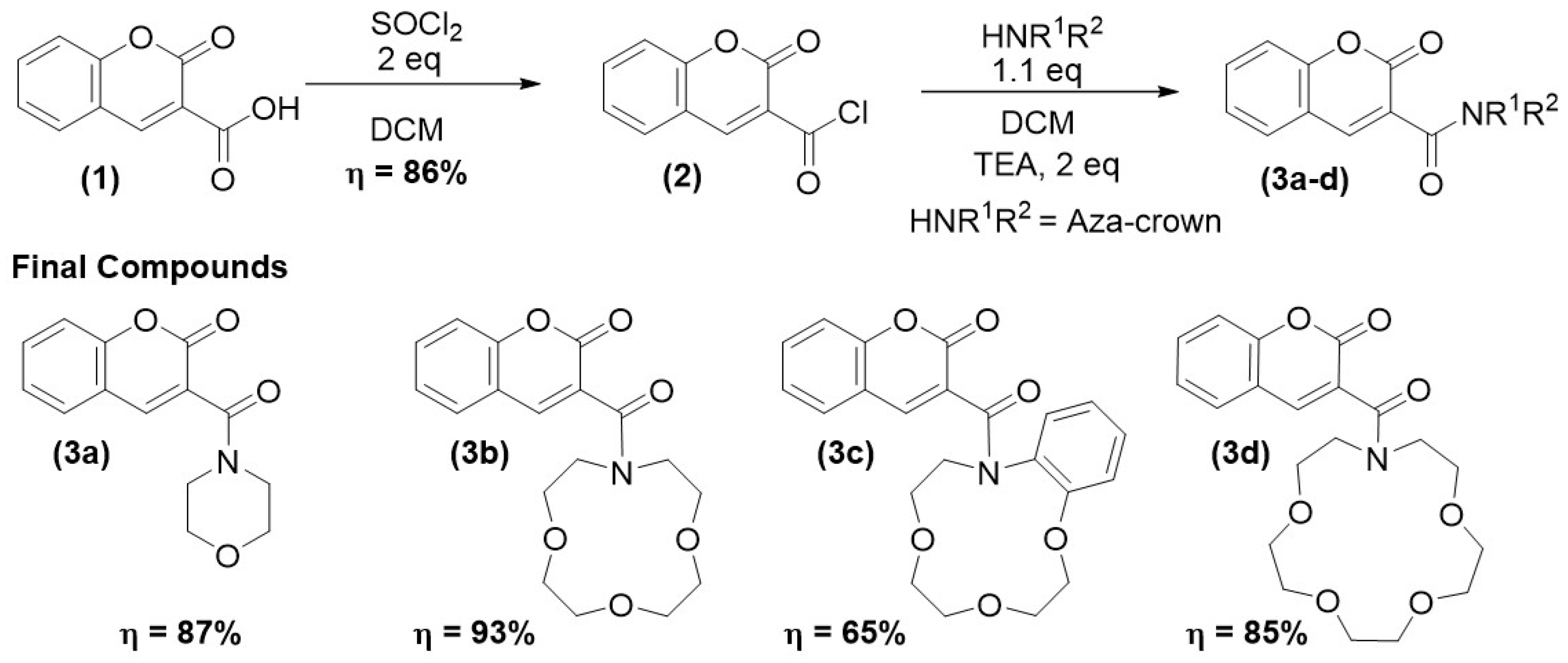
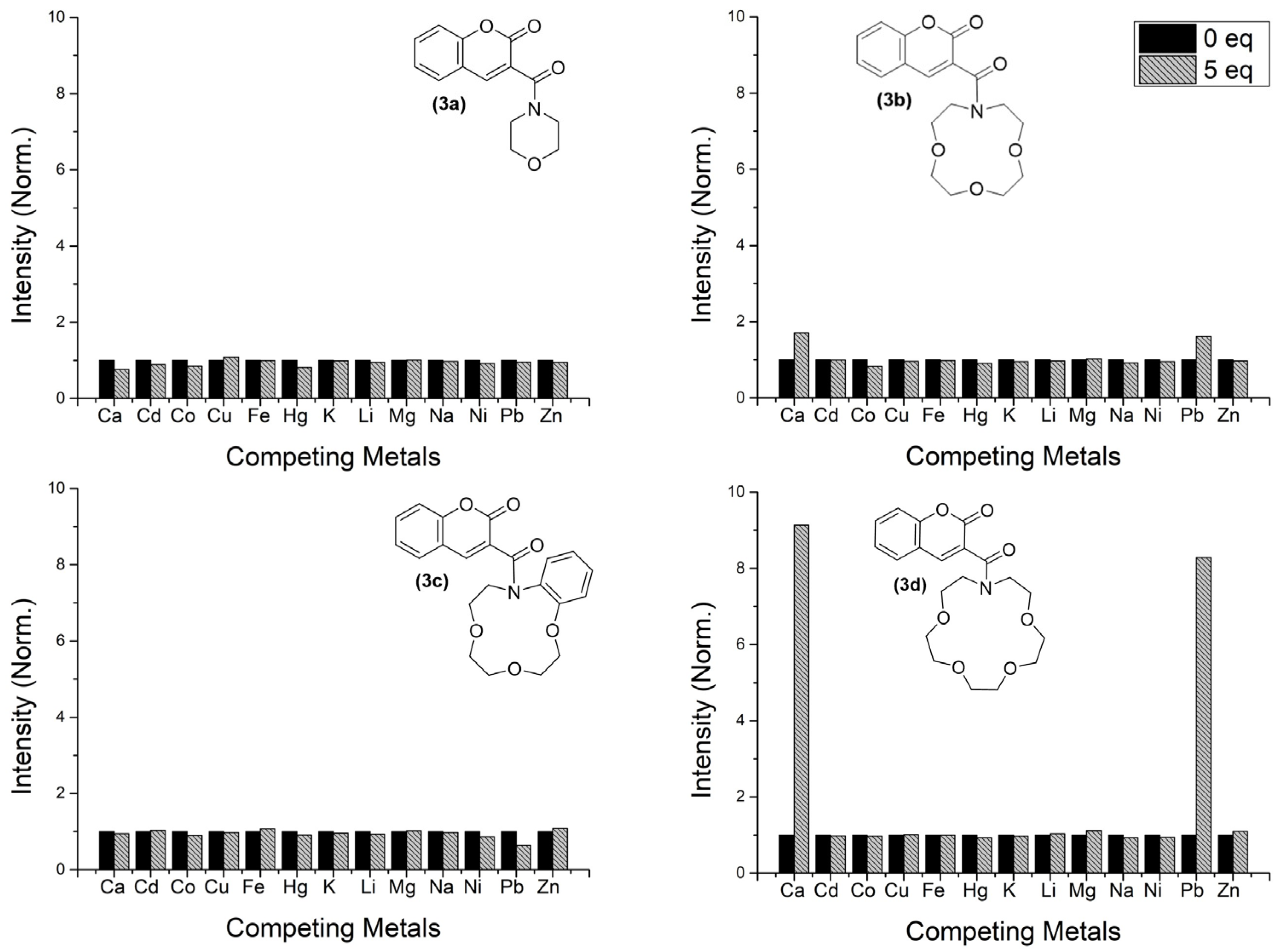
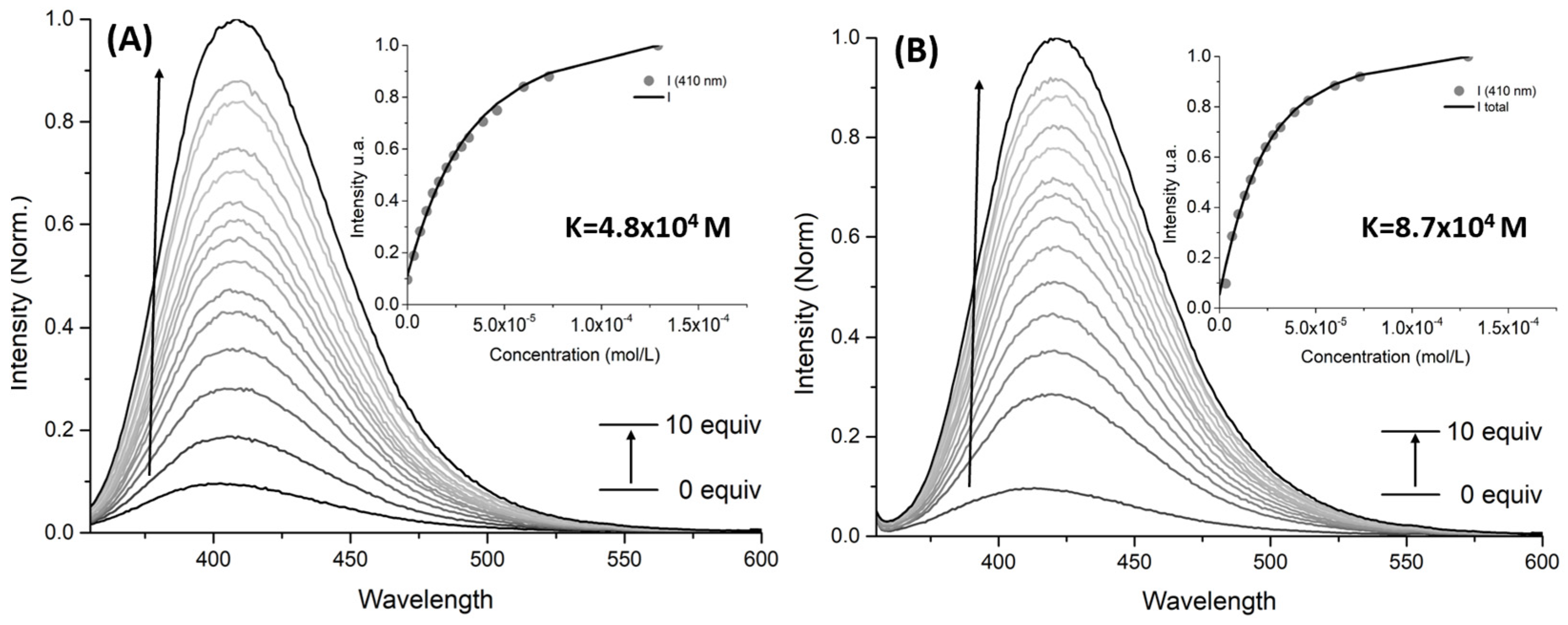

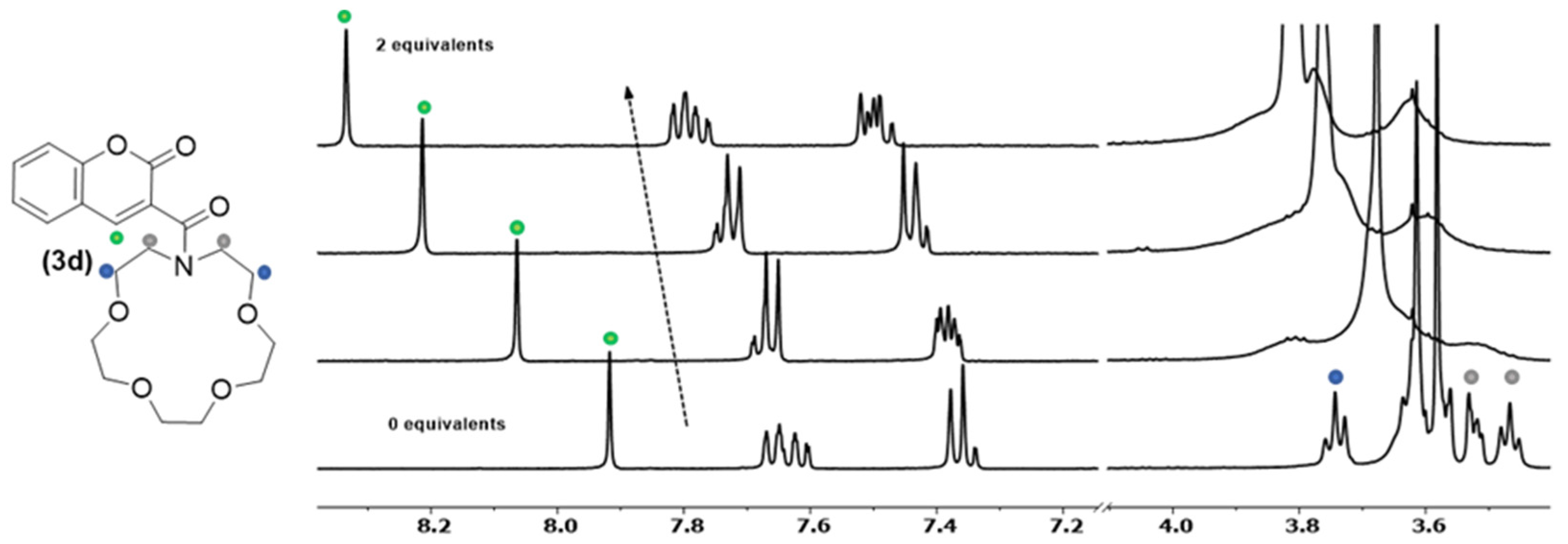



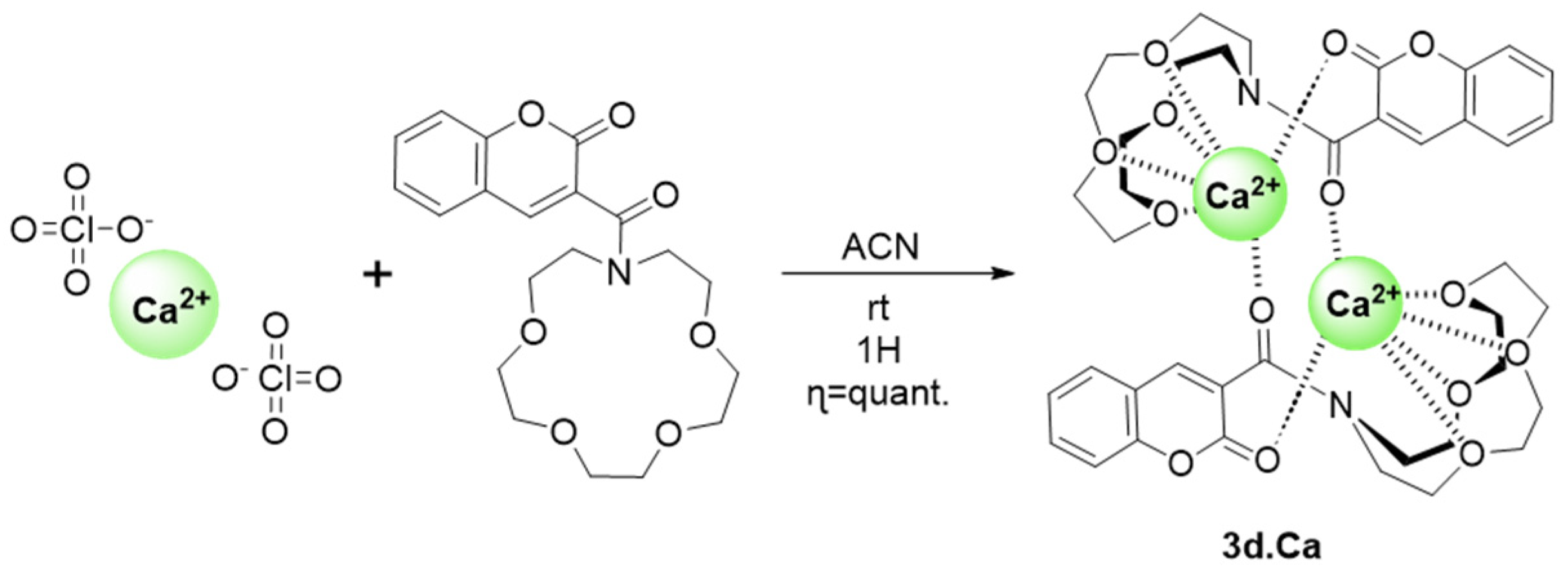

| Compound | λabs (nm) | λem (nm) | ε b (cm−1M−1) | Φ c (×10−4) |
|---|---|---|---|---|
| 3a | 285 a, 310 | 408 | 10,908 | 1.62 |
| 3b | 285 a, 315 | 403 | 7501 | 2.05 |
| 3c | 280 a, 320 | 400 | 7973 | 0.361 |
| 3d | 285 a, 315 | 405 | 10,414 | 3.51 |
| Compound | Kcalcium (M−1) | Klead (M−1) |
|---|---|---|
| 3b | 3.4 × 103 | 5.3 × 103 |
| 3c | - | 2.2 × 104 |
| 3d | 4.8 × 104 | 8.7 × 104 |
| Atoms | Distance (Å) | Moiety |
|---|---|---|
| O(2)-Ca(1) | 2.475(7) | Azacrown |
| O(3)-Ca(1) | 2.727(7) | Azacrown |
| O(4)-Ca(1) | 2.505(6) | Azacrown |
| O(5)-Ca(1) | 2.418(7) | Azacrown |
| O(6)-Ca(1) | 2.369(7) | Coumarin |
| O(8)-Ca(1) | 2.410(2) | - |
| O(13)-Ca(1) | 2.488(2) | - |
| O(1) #-Ca(1) * | 2.376(7) | Coumarin |
Disclaimer/Publisher’s Note: The statements, opinions and data contained in all publications are solely those of the individual author(s) and contributor(s) and not of MDPI and/or the editor(s). MDPI and/or the editor(s) disclaim responsibility for any injury to people or property resulting from any ideas, methods, instructions or products referred to in the content. |
© 2024 by the authors. Licensee MDPI, Basel, Switzerland. This article is an open access article distributed under the terms and conditions of the Creative Commons Attribution (CC BY) license (https://creativecommons.org/licenses/by/4.0/).
Share and Cite
Gomes, L.J.; Outis, M.; Gomes, C.S.B.; Tomé, A.C.; Moro, A.J. Development of Fluorescent Chemosensors for Calcium and Lead Detection. Molecules 2024, 29, 527. https://doi.org/10.3390/molecules29020527
Gomes LJ, Outis M, Gomes CSB, Tomé AC, Moro AJ. Development of Fluorescent Chemosensors for Calcium and Lead Detection. Molecules. 2024; 29(2):527. https://doi.org/10.3390/molecules29020527
Chicago/Turabian StyleGomes, Liliana J., Mani Outis, Clara S. B. Gomes, Augusto C. Tomé, and Artur J. Moro. 2024. "Development of Fluorescent Chemosensors for Calcium and Lead Detection" Molecules 29, no. 2: 527. https://doi.org/10.3390/molecules29020527






